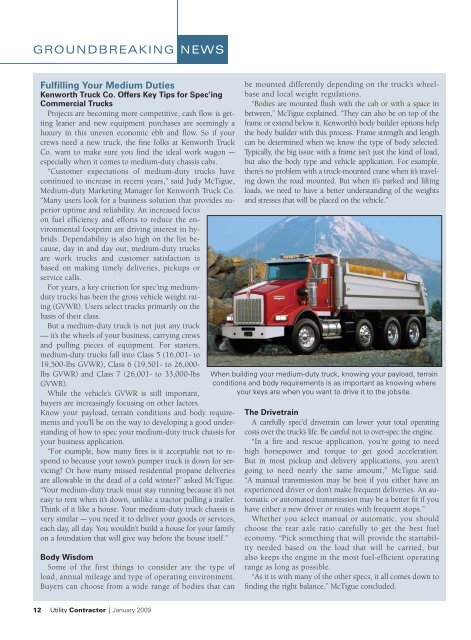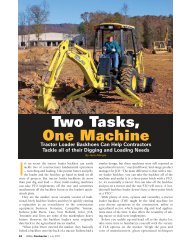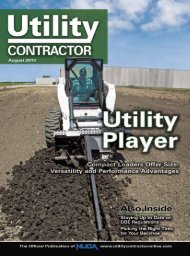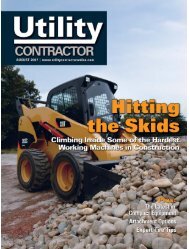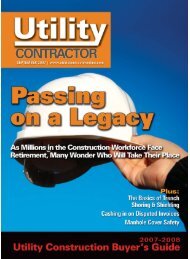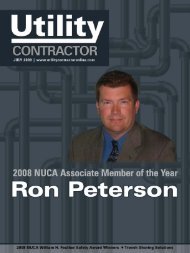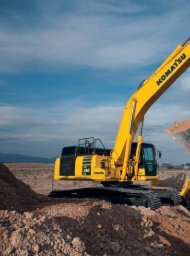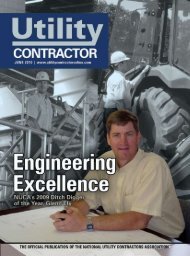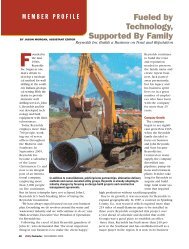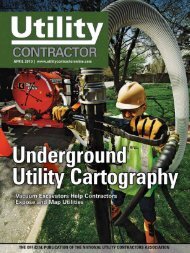View Full January PDF Issue - Utility Contractor Online
View Full January PDF Issue - Utility Contractor Online
View Full January PDF Issue - Utility Contractor Online
Create successful ePaper yourself
Turn your PDF publications into a flip-book with our unique Google optimized e-Paper software.
GROUNDBREAKING NEWSFulfilling Your Medium DutiesKenworth Truck Co. Offers Key Tips for Spec’ingCommercial TrucksProjects are becoming more competitive, cash flow is gettingleaner and new equipment purchases are seemingly aluxury in this uneven economic ebb and flow. So if yourcrews need a new truck, the fine folks at Kenworth TruckCo. want to make sure you find the ideal work wagon —especially when it comes to medium-duty chassis cabs.“Customer expectations of medium-duty trucks havecontinued to increase in recent years,” said Judy McTigue,Medium-duty Marketing Manager for Kenworth Truck Co.“Many users look for a business solution that provides superioruptime and reliability. An increased focuson fuel efficiency and efforts to reduce the environmentalfootprint are driving interest in hybrids.Dependability is also high on the list because,day in and day out, medium-duty trucksare work trucks and customer satisfaction isbased on making timely deliveries, pickups orservice calls.For years, a key criterion for spec’ing mediumdutytrucks has been the gross vehicle weight rating(GVWR). Users select trucks primarily on thebasis of their class.But a medium-duty truck is not just any truck— it’s the wheels of your business, carrying crewsand pulling pieces of equipment. For starters,medium-duty trucks fall into Class 5 (16,001- to19,500-lbs GVWR), Class 6 (19,501- to 26,000-lbs GVWR) and Class 7 (26,001- to 33,000-lbsGVWR).While the vehicle’s GVWR is still important,buyers are increasingly focusing on other factors.Know your payload, terrain conditions and body requirementsand you’ll be on the way to developing a good understandingof how to spec your medium-duty truck chassis foryour business application.“For example, how many fires is it acceptable not to respondto because your town’s pumper truck is down for servicing?Or how many missed residential propane deliveriesare allowable in the dead of a cold winter?” asked McTigue.“Your medium-duty truck must stay running because it’s noteasy to rent when it’s down, unlike a tractor pulling a trailer.Think of it like a house. Your medium-duty truck chassis isvery similar — you need it to deliver your goods or services,each day, all day. You wouldn’t build a house for your familyon a foundation that will give way before the house itself.”Body WisdomSome of the first things to consider are the type ofload, annual mileage and type of operating environment.Buyers can choose from a wide range of bodies that canbe mounted differently depending on the truck’s wheelbaseand local weight regulations.“Bodies are mounted flush with the cab or with a space inbetween,” McTigue explained. “They can also be on top of theframe or extend below it. Kenworth’s body builder options helpthe body builder with this process. Frame strength and lengthcan be determined when we know the type of body selected.Typically, the big issue with a frame isn’t just the kind of load,but also the body type and vehicle application. For example,there’s no problem with a truck-mounted crane when it’s travelingdown the road mounted. But when it’s parked and liftingloads, we need to have a better understanding of the weightsand stresses that will be placed on the vehicle.”When building your medium-duty truck, knowing your payload, terrainconditions and body requirements is as important as knowing whereyour keys are when you want to drive it to the jobsite.The DrivetrainA carefully spec’d drivetrain can lower your total operatingcosts over the truck’s life. Be careful not to over-spec the engine.“In a fire and rescue application, you’re going to needhigh horsepower and torque to get good acceleration.But in most pickup and delivery applications, you aren’tgoing to need nearly the same amount,” McTigue said.“A manual transmission may be best if you either have anexperienced driver or don’t make frequent deliveries. An automaticor automated transmission may be a better fit if youhave either a new driver or routes with frequent stops.”Whether you select manual or automatic, you shouldchoose the rear axle ratio carefully to get the best fueleconomy. “Pick something that will provide the startabilityneeded based on the load that will be carried, butalso keeps the engine in the most fuel-efficient operatingrange as long as possible.“As it is with many of the other specs, it all comes down tofinding the right balance,” McTigue concluded.12 <strong>Utility</strong> <strong>Contractor</strong> | <strong>January</strong> 2009


